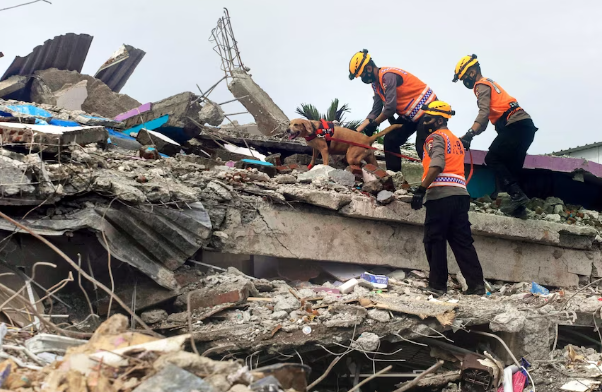Military regime’s offices and staff housing destroyed in the quake, plunging Naypyitaw and Mandalay into disarray

The powerful 7.7-magnitude earthquake that hit Myanmar has caused widespread damage to important infrastructure, including power systems, roads, and bridges. The tremors disrupted electricity, water, and communication services in affected areas, including the capital of Naypyitaw.
State-run media reported Monday that the earthquake caused severe damage to buildings and infrastructure, with the highest casualty tolls recorded in Mandalay, Sagaing, and Naypyitaw. In Naypyitaw, the quake has damaged ministerial buildings, staff housing complexes, roads, bridges, power lines, substations, transformers, and other critical infrastructure.
Repair efforts are underway, with approximately 560 electrical workers deployed in the capital, and 549 in Mandalay, according to junta media reports. Travelers have reported significant damage to the 366-mile-long Yangon-Mandalay Expressway, along with older inter-city roads, which have buckled, cracked, and sustained damage to bridges.
The earthquake damaged several key buildings, including the Ministry of Foreign Affairs, the Ministry of Labor, the Ministry of Transport and Communications, and Myanmar Railways. Staff housing complexes were also hit, with damage reported to Kha Yae buildings 132, 133, and 134, as well as buildings 1322, 1327, and 1307 in the Acre 1,000 complex. Additional damage occurred at staff housing in the Acre 2,000 and Acre 3,000 areas.
Military junta’s offices destroyed
Mandalay, the city most severely affected by the earthquake, remains in a full blackout.
In Naypyitaw, the quake damaged ministry offices, staff housing, and other infrastructure, forcing residents to rely on generators and solar power for electricity, a former military officer told Myanmar Now.
“Civil service staff have to sleep outside at night. They don’t dare return to their homes,” the former military officer, who requested anonymity, said. “Some civil servants died. Fences and walls of some six-story housing complexes collapsed. However, there were almost no casualties in the military staff quarters.”
He added that the most challenging aspect was that electricity had not been restored by Sunday, forcing them to rely on solar generators.
Buildings belonging to the Ministry of Home Affairs, as well as departmental offices and staff housing, also collapsed during the quake, killing and injuring several people, sources say. Staff from the military regime are reportedly sheltering in nearby areas.
Information Minister Maung Maung Ohn visited the collapsed staff housing on Sunday, describing the earthquake as the most powerful in over a century. Military personnel are now living in temporary tents, including in football fields, and relief supplies.
So far, arrangements have been made for water supply, temporary toilets, and phone charging stations, the junta said in a statement issued Monday. The entire administration of the military regime in Naypyitaw has been suspended, operating only in townships that were not severely affected by the quake. Even ministry websites have been disrupted.
An emergency online meeting of ASEAN foreign ministers on earthquake relief was held on Sunday. Among those attending were the deputy prime minister and foreign minister of the military junta, who were seen participating outside a damaged building after losing access to their office.
Myanmar has been operating under a rotating power supply system for over four years since the coup. The collapse of power lines during the earthquake has worsened the situation, plunging Naypyitaw, Mandalay, and Sagaing into blackouts. In Yangon, which was less affected by the quake, electricity is currently available for only about two hours a day.
Although some townships reportedly had power restored as of Monday morning, most areas remain without electricity, making it difficult to charge phones or pump water, a Naypyitaw resident said.
A woman from Mandalay told Myanmar Now that numerous residents are now sleeping on the streets and in fields near the moat, fearing that further buildings could collapse.
Electricity, telephone, and internet services are down. Some residents with solar power systems are helping others by offering mobile phone charging. In Yangon, residents are also struggling to cook and access clean drinking water due to limited electricity, and many businesses have been forced to close.
The junta is working to repair the damaged power grid, but the timeline for restoration could range from 10 days to several months, depending on the availability of spare parts, sources say.
A source in the electricity sector, speaking anonymously, said repairs have been quicker post-coup due to a sufficient stock of spare parts. Power lines should be restored within 10 days, but damaged transformers may take one to two months to repair, depending on location.
Highways and bridges collapse
The recent earthquake severely damaged towns along the two major highways connecting Yangon and Mandalay, including Naypyitaw, Pyinmana, and Meiktila. On the over-360-mile-long Yangon-Mandalay Expressway, bridges collapsed and road surfaces were badly damaged. The highway is only usable from Yangon to Milepost 138, with closures between Mileposts 138 and 200 leading into Naypyitaw.
“There’s almost no traffic, except for express buses. Private cars are rare. Several bridges, including the one over Swa Creek, have collapsed,” the toll employee said.
Due to the road closure at Milepost 138, vehicles are being diverted to the Ottatwin section, which connects to the old highway. As a result, traffic on the expressway has significantly decreased, and more vehicles are now using the old highway.
According to the Myanmar Information Management Unit (MIMU) of the United Nations Development Programme (UNDP), the powerful earthquake caused bridges to collapse between Mileposts 93 and 134 on the new expressway, and parts of the road have sunk by five to 10 inches.
More than 20 locations along the Yangon–Naypyitaw expressway were damaged, extending travel times from eight to over 11 hours. The old highway also sustained cracks, affecting roads to nearby towns.
The United Nations, the United States, China, India, the European Union, and other international organisations have pledged aid and rescue efforts for earthquake victims.
“The consequences of the earthquake are severe,” a Naypyitaw resident told Myanmar Now. “Life in Naypyitaw has become extremely difficult—we’re in a very challenging situation.”

